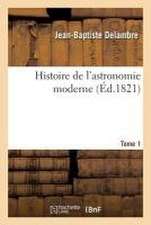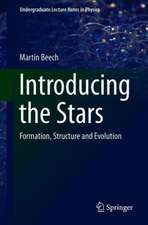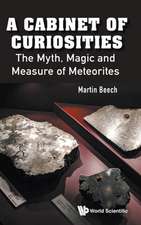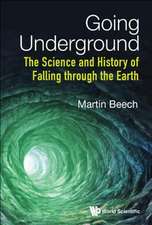Terraforming: The Creating of Habitable Worlds: Astronomers' Universe
Autor Martin Beechen Limba Engleză Paperback – 23 aug 2016
Din seria Astronomers' Universe
-
 Preț: 210.44 lei
Preț: 210.44 lei -
 Preț: 207.15 lei
Preț: 207.15 lei -
 Preț: 195.53 lei
Preț: 195.53 lei -
 Preț: 254.90 lei
Preț: 254.90 lei -
 Preț: 284.56 lei
Preț: 284.56 lei -
 Preț: 256.41 lei
Preț: 256.41 lei -
 Preț: 264.35 lei
Preț: 264.35 lei -
 Preț: 259.08 lei
Preț: 259.08 lei -
 Preț: 227.61 lei
Preț: 227.61 lei -
 Preț: 277.98 lei
Preț: 277.98 lei -
 Preț: 305.70 lei
Preț: 305.70 lei -
 Preț: 253.11 lei
Preț: 253.11 lei -
 Preț: 216.60 lei
Preț: 216.60 lei -
 Preț: 272.24 lei
Preț: 272.24 lei -
 Preț: 330.75 lei
Preț: 330.75 lei -
 Preț: 179.00 lei
Preț: 179.00 lei -
 Preț: 289.83 lei
Preț: 289.83 lei -
 Preț: 160.03 lei
Preț: 160.03 lei -
 Preț: 200.80 lei
Preț: 200.80 lei -
 Preț: 255.97 lei
Preț: 255.97 lei -
 Preț: 242.58 lei
Preț: 242.58 lei -
 Preț: 262.55 lei
Preț: 262.55 lei -
 Preț: 282.38 lei
Preț: 282.38 lei -
 Preț: 187.82 lei
Preț: 187.82 lei -
 Preț: 225.19 lei
Preț: 225.19 lei -
 Preț: 207.64 lei
Preț: 207.64 lei -
 Preț: 104.35 lei
Preț: 104.35 lei -
 Preț: 188.94 lei
Preț: 188.94 lei -
 Preț: 270.49 lei
Preț: 270.49 lei -
 Preț: 212.01 lei
Preț: 212.01 lei -
 Preț: 169.08 lei
Preț: 169.08 lei -
 Preț: 210.01 lei
Preț: 210.01 lei -
 Preț: 208.26 lei
Preț: 208.26 lei -
 Preț: 253.98 lei
Preț: 253.98 lei -
 Preț: 180.12 lei
Preț: 180.12 lei -
 Preț: 280.19 lei
Preț: 280.19 lei -
 Preț: 273.13 lei
Preț: 273.13 lei -
 Preț: 207.39 lei
Preț: 207.39 lei -
 Preț: 208.70 lei
Preț: 208.70 lei -
 Preț: 214.86 lei
Preț: 214.86 lei -
 Preț: 188.94 lei
Preț: 188.94 lei -
 Preț: 194.65 lei
Preț: 194.65 lei -
 Preț: 277.34 lei
Preț: 277.34 lei -
 Preț: 187.15 lei
Preț: 187.15 lei -
 Preț: 210.93 lei
Preț: 210.93 lei -
 Preț: 212.01 lei
Preț: 212.01 lei
Preț: 212.88 lei
Nou
Puncte Express: 319
Preț estimativ în valută:
40.73€ • 42.53$ • 33.71£
40.73€ • 42.53$ • 33.71£
Carte disponibilă
Livrare economică 14-28 martie
Preluare comenzi: 021 569.72.76
Specificații
ISBN-13: 9781493939145
ISBN-10: 1493939149
Pagini: 304
Ilustrații: XI, 291 p.
Dimensiuni: 155 x 235 x 16 mm
Greutate: 0.43 kg
Ediția:Softcover reprint of the original 1st ed. 2009
Editura: Springer
Colecția Springer
Seria Astronomers' Universe
Locul publicării:New York, NY, United States
ISBN-10: 1493939149
Pagini: 304
Ilustrații: XI, 291 p.
Dimensiuni: 155 x 235 x 16 mm
Greutate: 0.43 kg
Ediția:Softcover reprint of the original 1st ed. 2009
Editura: Springer
Colecția Springer
Seria Astronomers' Universe
Locul publicării:New York, NY, United States
Cuprins
Prolog: The Big Guns of Kugluktuk.- Life in the Solar System, and Beyond.- The Limits of the World.- In the Right Place at the Right Time.- The Terraforming of Mars.- The Terraforming of Venus.- An Abundance of Habitats.
Recenzii
From the reviews:
"Earth will not last forever; it will take many human generations for most of Earth’s problems to manifest, at the very least. One may consider these the problems of far-off generations or, as Beech … does in Terraforming, one might consider how to begin to create new homes on Mars or Venus. Beech describes our modern view of the solar system, emphasizing the resources available to us on the familiar planets … . Summing Up: Recommended. General and academic audiences, lower-division undergraduate and above." (C. Palma, Choice, Vol. 47 (1), September, 2009)
“‘The ultimate aim of terraforming is to alter a hostile planetary environment into one that is Earth like, and eventually upon the surface of the new and vibrant world that you and I could walk freely about and explore.’ … nicely produced and illustrated book, then carries on with a mixture of just enough actual scientific detail to make the extensive science fantasy, not science fiction but science fantasy, plausible to many readers. … interest to scientists and engineers … .” (Gary J. Long and Fernande Grandjean, Belgian Physical Society Magazine, Issue 2, 2011)
"Earth will not last forever; it will take many human generations for most of Earth’s problems to manifest, at the very least. One may consider these the problems of far-off generations or, as Beech … does in Terraforming, one might consider how to begin to create new homes on Mars or Venus. Beech describes our modern view of the solar system, emphasizing the resources available to us on the familiar planets … . Summing Up: Recommended. General and academic audiences, lower-division undergraduate and above." (C. Palma, Choice, Vol. 47 (1), September, 2009)
“‘The ultimate aim of terraforming is to alter a hostile planetary environment into one that is Earth like, and eventually upon the surface of the new and vibrant world that you and I could walk freely about and explore.’ … nicely produced and illustrated book, then carries on with a mixture of just enough actual scientific detail to make the extensive science fantasy, not science fiction but science fantasy, plausible to many readers. … interest to scientists and engineers … .” (Gary J. Long and Fernande Grandjean, Belgian Physical Society Magazine, Issue 2, 2011)
Notă biografică
Associate professor of astronomy, and Head of the Astronomy Department at Campion College, The University of Regina. My main research interests during the past decade have focused on the smaller objects within the solar system (comets, asteroids and meteoroids), but concomitant to this I have continued to perform research related to the structure and evolution of stars (the area of my doctoral studies). The book being proposed here is partly based upon a series of research papers that I have published over the years and on material used in a solar system studies class. The topic of asteroengineering was recently the focus of an ‘opinion article’ I wrote for the May 2006 issue of Astronomy Now magazine, and an editorial piece in the May 2006 issue of Smithsonian Air and Space magazine.
Home web page: http://hyperion.cc.uregina.ca/~astro/mbeech.html
Home web page: http://hyperion.cc.uregina.ca/~astro/mbeech.html
Textul de pe ultima copertă
We all know that Earth’s population is growing at an alarming rate, and vital resources are becoming scarce. There simply isn’t enough space to grow the food the bulging human populations will need in the future. An energy crisis is also upon us. What happens when the oil runs out or becomes too costly to support us in the lifestyles to which we’ve become accustomed? What do we do?
There are no easy solutions. Planned population growth would certainly be a possible solution, but there are probably already too many mouths too feed, and few nations would be willing to pass or enforce laws limiting their country’s birth rate.
Some scientists have suggested the answer lies in humankind’s spacefaring nature and fantastic engineering capabilities. We know that there are other terrestrial bodies in our Solar System that share some features with Earth. Can they be made habitable, or at least be used to grow food or supply energy to Earth’s expanding populations? What would it take? Which of those bodies are our best hope? Can we create an atmosphere where there is none or change a poisonous atmosphere to one we can breathe?
These and other questions concerning modern-day realities and the future possibilities of terraforming—the science of making of new worlds (even extrasolar ones) habitable for humans—are tackled in this engrossing and revealing study by Martin Beech.
There are no easy solutions. Planned population growth would certainly be a possible solution, but there are probably already too many mouths too feed, and few nations would be willing to pass or enforce laws limiting their country’s birth rate.
Some scientists have suggested the answer lies in humankind’s spacefaring nature and fantastic engineering capabilities. We know that there are other terrestrial bodies in our Solar System that share some features with Earth. Can they be made habitable, or at least be used to grow food or supply energy to Earth’s expanding populations? What would it take? Which of those bodies are our best hope? Can we create an atmosphere where there is none or change a poisonous atmosphere to one we can breathe?
These and other questions concerning modern-day realities and the future possibilities of terraforming—the science of making of new worlds (even extrasolar ones) habitable for humans—are tackled in this engrossing and revealing study by Martin Beech.
Caracteristici
Explains how other parts of the solar system and even exoplanets can be made fit for human settlement and how our solar system offers an abundance of resources Shows how geological and chemical activity in Earth's atmosphere allow Earth to support life and how other solar system objects might be fashioned similarly Explores in detail the current thinking on how a terraformed, life-sustaining Mars might be possible, given that Mars was once a much wetter and denser planet






























